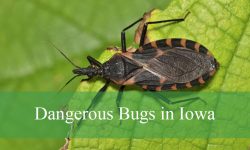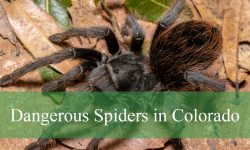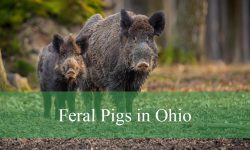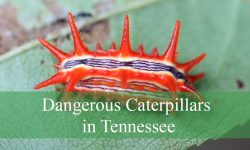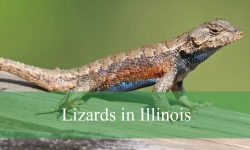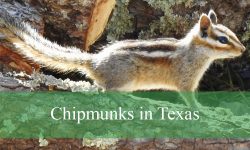The other day, I glanced out into my backyard and caught sight of a stunning little bird—bright yellow with bold black wings. Its vibrant colors stood out sharply against the green trees, and I couldn’t help but wonder: What kind of bird was that? The moment felt fleeting, but it sparked a deep curiosity in me.
After doing some digging, I realized I wasn’t alone in asking this question. Yellow birds with black wings are not only visually striking, but they’re also more common than I thought—appearing in various regions across the world. From quiet suburban gardens to dense rainforests, these birds can be found just about anywhere if you know what to look for.
That one backyard sighting led me down a delightful rabbit hole of bird identification. In this article, I’ve gathered 32 yellow birds with black wings, complete with pictures and key details to help others recognize them too. For bird lovers and casual observers alike, this list offers a useful guide to spotting these beautiful birds.
Different Types of Yellow Birds With Black Wings
American Goldfinch (Spinus tristis)
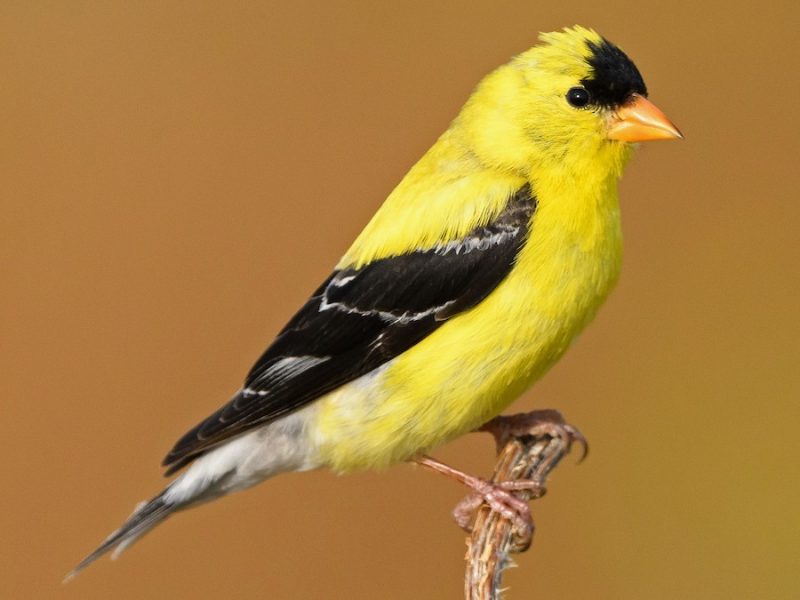
The American Goldfinch is a small, vibrant songbird well-known for its striking breeding plumage. Males turn a vivid lemon-yellow in the spring and summer, with jet-black wings and a black cap that contrasts sharply with their body. Females and non-breeding males are more subdued in color, showing olive-brown tones with duller yellow underparts and dark wings without the dramatic black cap.
This species is widespread throughout North America, ranging from southern Canada down to northern Mexico, depending on the season. It prefers open habitats such as fields, meadows, and suburban gardens, particularly areas rich in weedy growth. The goldfinch is a late breeder, often nesting in July or August when thistle plants, a key food source, are at their peak.
Primarily granivorous, American Goldfinches feed on seeds from thistles, sunflowers, asters, and other weedy plants. They are agile and acrobatic feeders, often clinging to seedheads or bird feeders in flocks. Their bouncy, undulating flight pattern and sweet, tinkling calls make them easy to identify in the field.
Western Tanager (Piranga ludoviciana)
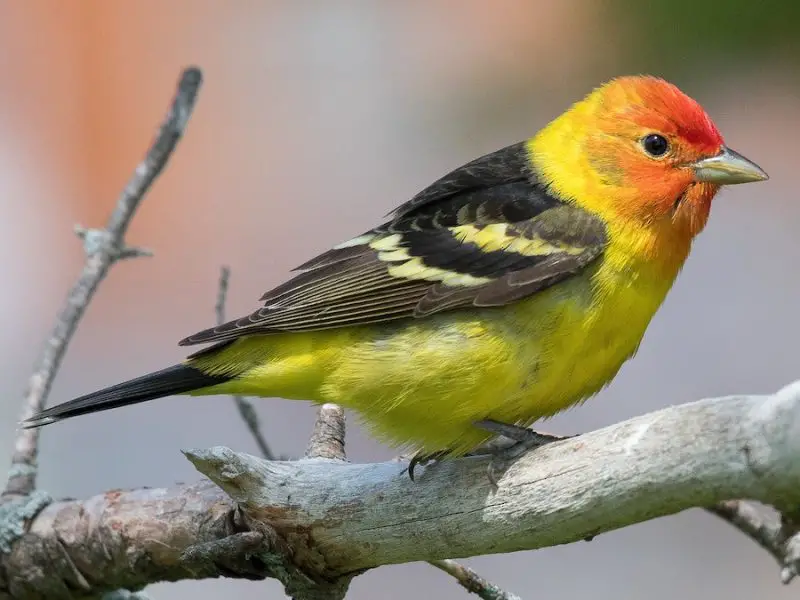
The Western Tanager is a striking bird, especially the male, which sports a bright yellow body, a red-orange face, and contrasting black wings with two prominent white wing bars. Females and immatures are duller, showing more olive-yellow tones with grayish wings. This bold coloration helps males stand out during the breeding season.
Western Tanagers are found in the coniferous forests of the western United States, stretching from Alaska to Mexico during migration and breeding. They prefer mixed woodlands, especially those with pines, firs, or spruce. During migration, they may also be found in lower elevations and even in suburban areas with adequate tree cover.
Their diet consists primarily of insects during the breeding season, including beetles, ants, wasps, and caterpillars. They also consume berries and fruits, particularly during migration. Western Tanagers are known for their high-pitched, robin-like song, and while they can be elusive, their vibrant coloring gives them away when perched in treetops.
Scott’s Oriole (Icterus parisorum)

Scott’s Oriole is a medium-sized songbird distinguished by its bright yellow underparts and stark black head, back, and wings. Males are particularly vivid, while females are paler with more olive-yellow tones and slightly less contrast in their plumage. Their long tail and slim body give them an elegant appearance.
These orioles inhabit arid regions of the southwestern United States and Mexico, favoring open woodlands, desert scrub, and foothill slopes dotted with yucca, juniper, or agave. They are closely associated with desert habitats and often nest in yucca plants or similar spiny vegetation.
Scott’s Orioles are omnivorous, feeding on insects, nectar, and fruit. They are skilled at gleaning insects from foliage and are also drawn to hummingbird feeders for sugar water. Their clear, whistling song is often heard echoing across desert landscapes, especially during the early morning.
Baltimore Oriole (Icterus galbula)
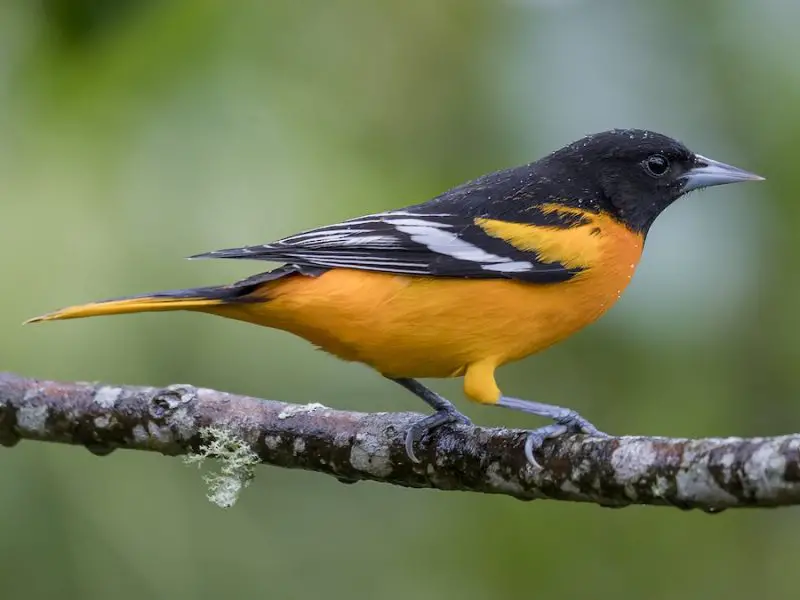
The Baltimore Oriole is one of the most recognizable birds in eastern North America, with adult males showcasing a brilliant orange-yellow body, black head, and jet-black wings highlighted with white wing bars. Females are more yellow-orange with grayish or brownish wings and lack the stark black head.
This species breeds in open woodlands, forest edges, and suburban parks throughout the eastern United States and southern Canada. During migration, they travel to Central America, northern South America, and the Caribbean, using forest edges and gardens along the way. They often weave hanging, pouch-like nests in tall deciduous trees.
Baltimore Orioles primarily feed on insects, fruit, and nectar. They are especially fond of ripe fruits like oranges and berries, and are common visitors at backyard feeders that offer jelly or cut fruit. Their flutelike song and chattering calls make them an auditory delight as well as a visual one.
Hooded Oriole (Icterus cucullatus)
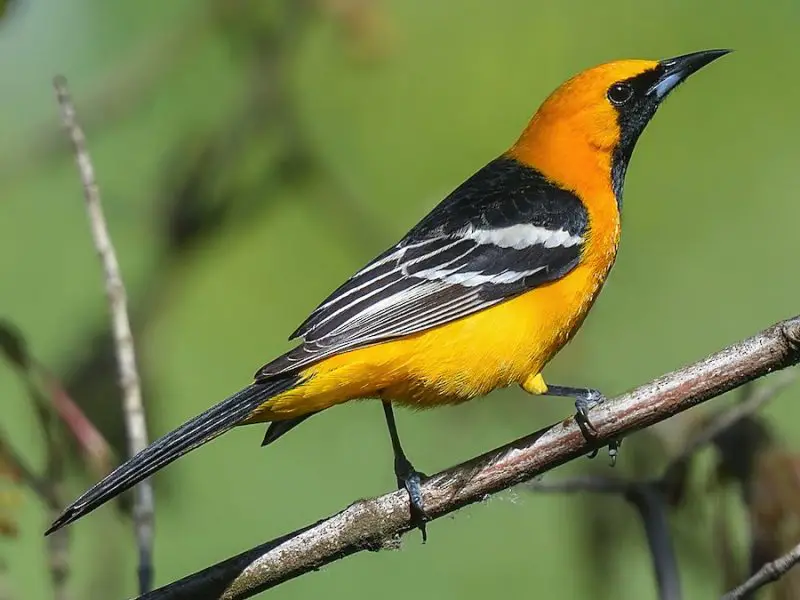
The Hooded Oriole is a brightly colored bird, with males exhibiting a striking yellow-orange body, black face and throat, and black wings that feature bold white wing bars. Females are more muted, usually light yellow with olive-gray wings. Their long, slightly curved bill is well-suited for sipping nectar.
Native to the southwestern United States and Mexico, Hooded Orioles are common in palm-lined urban areas, desert canyons, and riparian woodlands. They often build their nests in the fronds of palm trees, where the long, woven basket-like structures sway in the breeze.
They feed on insects, spiders, nectar, and fruit. Hooded Orioles are regular visitors to hummingbird feeders and are particularly attracted to sugar-water and orange halves. Their songs are variable and include a mix of squeaks and whistles, and their acrobatic movements make them a pleasure to observe in suburban gardens.
Yellow-headed Blackbird (Xanthocephalus xanthocephalus)
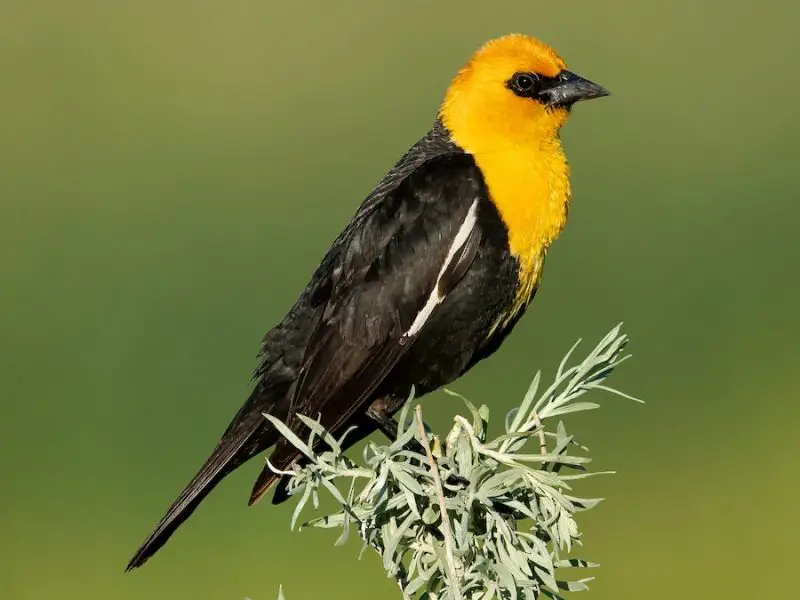
The Yellow-headed Blackbird is a striking marshland bird, instantly recognizable by its vivid yellow head and breast, which contrast sharply with its black body and wings. Males are especially bold in appearance, while females and immatures tend to be browner and have duller yellow markings. The bird has a large, conical bill and a somewhat stocky build.
This species is typically found in the wetlands of western and central North America during the breeding season, favoring cattail marshes, prairie potholes, and reed beds. In winter, large flocks migrate to the southwestern United States and northern Mexico, often mingling with other blackbird species in agricultural fields and open grasslands.
Yellow-headed Blackbirds feed primarily on seeds and grains, especially in winter, but also consume insects like beetles and grasshoppers during the breeding season. Their calls are harsh and mechanical, sometimes likened to a rusty hinge, and their gregarious behavior makes them conspicuous when present in large numbers.
Evening Grosbeak (Coccothraustes vespertinus)

The Evening Grosbeak is a chunky, thick-billed finch with a bright yellow body, contrasting black wings with bold white patches, and a dark head. Males have a vivid lemon-yellow body and a prominent white secondary wing patch, while females are more subdued in gray and olive tones. Both sexes have a massive pale bill adapted for seed-cracking.
Native to North America, Evening Grosbeaks inhabit coniferous and mixed forests, especially in the northern U.S. and Canada. Their populations are somewhat nomadic, often making irregular appearances in the winter months further south, depending on food availability, particularly in years of cone crop failure.
They feed on seeds, buds, and fruits, with a preference for maple, ash, and spruce seeds. They are also known to visit feeders offering sunflower seeds. Social and often noisy, Evening Grosbeaks travel in flocks and emit short, piercing whistles that help them stay in contact with each other in forest canopies.
Saffron Finch (Sicalis flaveola)

The Saffron Finch is a small, cheerful-looking bird known for its bright yellow plumage. Males are typically more vibrant, with some subspecies showing olive or blackish markings on the wings and nape. Females and juveniles are generally paler, sometimes with faint streaking. They have a rounded body and a small, conical bill.
Native to tropical South America, the Saffron Finch thrives in a variety of open habitats, including savannas, farmlands, urban parks, and gardens. It has been introduced to other areas, including Hawaii and parts of Central America, where it has adapted well to suburban environments.
Their diet includes seeds, fruits, and insects, and they often forage on the ground or visit feeders. Saffron Finches are gregarious and known for their melodious, chirping songs, which make them popular cage birds in some regions. They build simple nests in cavities or abandoned structures, sometimes even in mailboxes or rooftops.
Yellow Grosbeak (Pheucticus chrysopeplus)
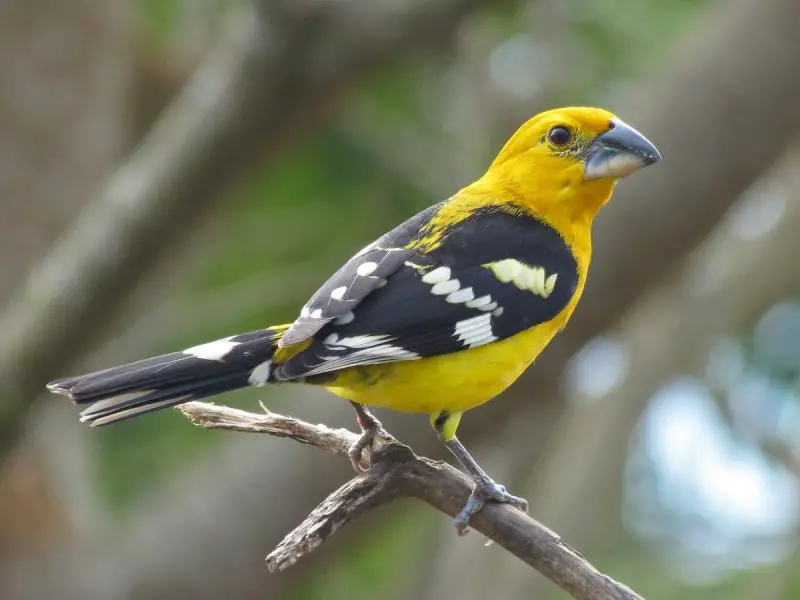
The Yellow Grosbeak is a large, robust songbird with a stunning golden-yellow body, black wings with prominent white spots, and a heavy, pale-colored bill. Males are particularly bright and bold, while females exhibit more muted yellow tones with similar wing patterns. Their size and strong bill make them resemble a large finch or cardinal.
This species is primarily found in the woodlands and forest edges of Mexico and parts of Central America, especially along the Pacific slope. They inhabit both dry and moist habitats and are often seen foraging high in the canopy or visiting fruiting trees.
Yellow Grosbeaks feed on seeds, fruits, and insects, using their powerful bill to crush hard seeds with ease. Although generally shy and elusive, they may come to feeders offering sunflower seeds. Their call is a sharp, metallic “cheek,” and their song is rich and warbling, often delivered from a hidden perch.
Golden Tanager (Tangara arthus)

The Golden Tanager is a dazzling neotropical bird with a vivid golden-yellow body accented by a black back, wings, and ear coverts. The contrast in coloration gives the bird a distinctly patterned appearance, with males and females appearing similar. The plumage looks especially vibrant against the lush green of its forest habitat.
This tanager is native to the Andean regions of South America, ranging from Venezuela through Colombia, Ecuador, and northern Peru. It is most commonly found in montane and cloud forests at elevations between 1,000 and 2,500 meters, where it travels in mixed-species flocks through the canopy and mid-levels.
Golden Tanagers feed on a variety of fruits, berries, and insects. They are active, agile foragers, often hopping through branches or hanging upside-down to access food. Their call is a series of high-pitched twitters, and their social behavior and vivid color make them a favorite among birdwatchers in the Andean tropics.
Black-hooded Oriole (Oriolus xanthornus)
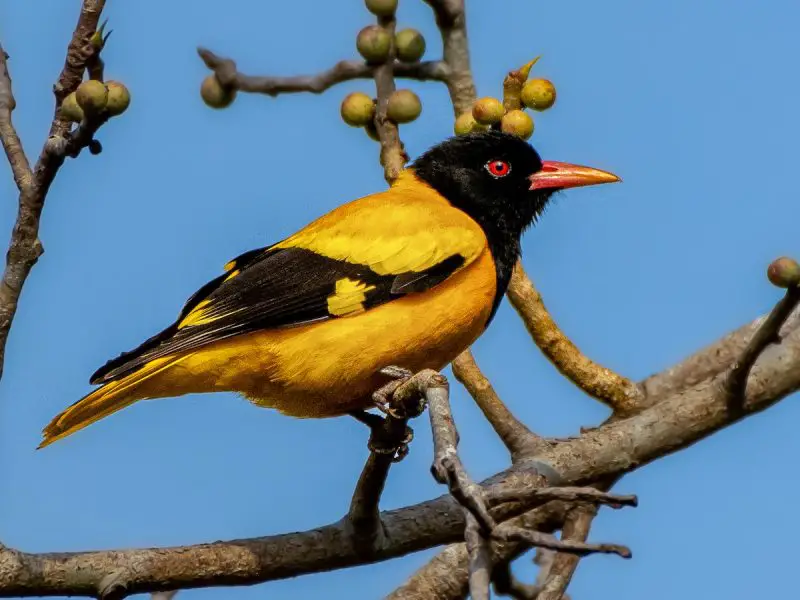
The Black-hooded Oriole is an eye-catching bird with a bright yellow body and a deep black hood covering its head, neck, and upper chest. Its wings are also black, providing a bold contrast that enhances its vivid appearance. The oriole’s strong red beak and bright red eyes further accentuate its striking coloration.
This species is widely distributed throughout the Indian subcontinent, including India, Sri Lanka, and parts of Bangladesh and Nepal. It inhabits a range of wooded environments such as forests, groves, gardens, and urban parks. It is often seen high in the canopy, moving gracefully through foliage in search of food.
Black-hooded Orioles feed on fruits, berries, nectar, and insects, using their slightly curved beak to probe into flowers or pick insects from leaves. They are known for their melodious, flute-like calls, which resonate through the treetops and are often heard before the bird is seen.
Yellow Oriole (Icterus nigrogularis)
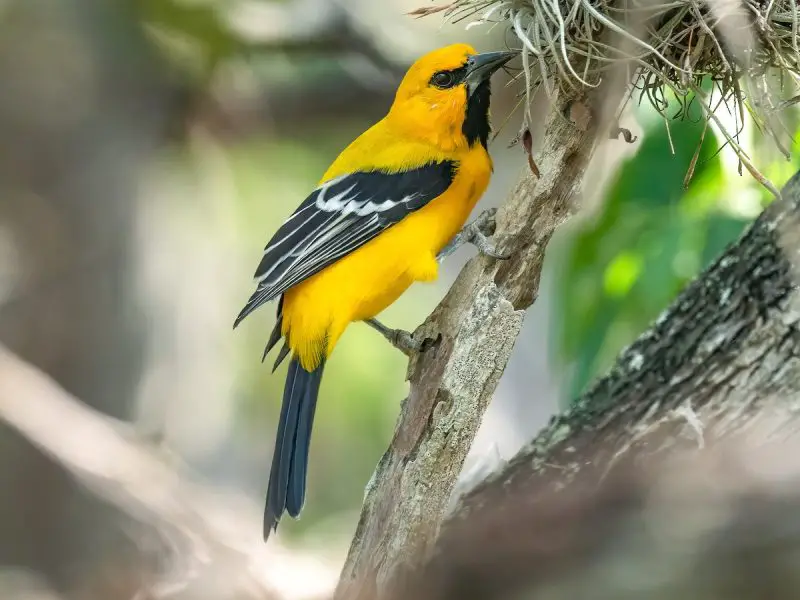
The Yellow Oriole is a brightly colored songbird with vivid yellow plumage and contrasting black markings on the wings and around the throat. Males and females are similar in appearance, though females may be slightly duller. Their slender build and long, slightly curved bill are typical of orioles.
This species is native to northern South America, including countries like Venezuela, Colombia, and parts of the Amazon basin. It inhabits open woodlands, forest edges, savannas, and even suburban areas where fruiting trees are present. Yellow Orioles are often seen perched in tall trees or flying between fruit-bearing branches.
Their diet consists primarily of fruits, nectar, and insects, which they glean from foliage or take mid-air. Yellow Orioles are noted for their rich, musical whistles, which they use to communicate and defend territory. They build deep, hanging nests woven from plant fibers, often suspended from high branches.
Yellow-rumped Cacique (Cacicus cela)
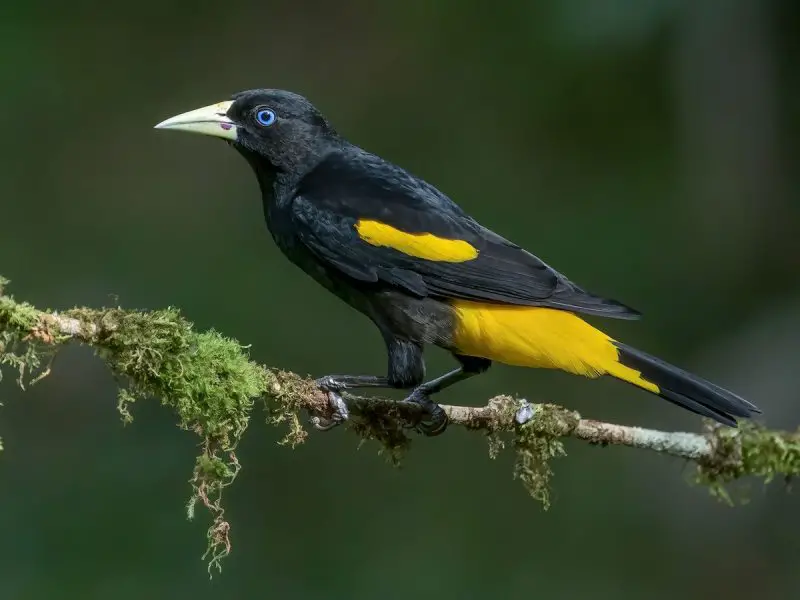
The Yellow-rumped Cacique is a medium-sized tropical bird with a glossy black body and bright yellow rump, wing linings, and undertail coverts. The brilliant yellow contrasts with its otherwise dark plumage, especially noticeable in flight. It has a sharp, pale-colored bill and a slender silhouette.
This species is native to the Amazon Basin and is widespread in countries such as Brazil, Peru, Ecuador, and Colombia. It inhabits lowland rainforests, riverine woodlands, and forest edges, often in the vicinity of water. Yellow-rumped Caciques are colonial breeders and are frequently seen in noisy flocks.
They feed on fruits, nectar, and insects, foraging in the canopy and mid-levels of the forest. Known for their complex vocalizations, which include whistles, squawks, and mimicry, they are vocal and social. Their hanging nests are built in large colonies, often high in trees and close to water sources.
Golden Oriole (Oriolus oriolus)
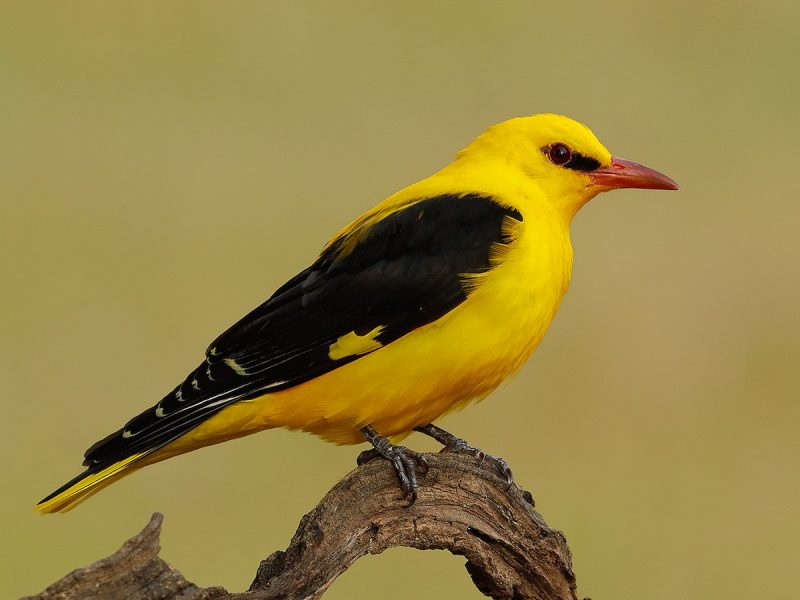
The Golden Oriole is a sleek and vibrant bird, with adult males displaying a golden-yellow body contrasted by jet-black wings and a thin black eye-stripe. Females are more greenish-yellow with less defined markings. The species has a strong, straight beak and a graceful, thrush-like shape.
Golden Orioles breed in Europe and western Asia and migrate to sub-Saharan Africa for the winter. They prefer deciduous woodlands, orchards, and groves with tall trees, often near water. Despite their bright coloration, they are elusive and tend to remain hidden in dense foliage.
Their diet includes insects, berries, and small fruits, which they forage quietly among leaves. The Golden Oriole is best known for its beautiful, fluting song, a clear, mellow whistle that is often heard throughout European woodlands in spring and summer. They nest high in trees, weaving a deep, cup-shaped nest from plant fibers.
Village Weaver (Ploceus cucullatus)

The Village Weaver is a colorful and industrious bird with a yellow body, black face mask, and black wings. Males are especially vibrant during the breeding season, while females are more subdued, with olive-yellow tones and less pronounced facial markings. The species has a stout build and a conical bill.
Native to sub-Saharan Africa, Village Weavers are commonly found in open savannas, agricultural areas, villages, and wetlands. They are highly adaptable and often live close to human habitation, building their nests in trees, reed beds, or on man-made structures such as utility poles and fences.
They primarily eat seeds, grains, and insects, and will also take fruit and nectar. Village Weavers are famous for their intricate, woven nests—spherical structures with a side entrance, suspended from branches. Males build multiple nests to attract females and often live in large, noisy colonies near water.
Yellow Bishop (Euplectes capensis)
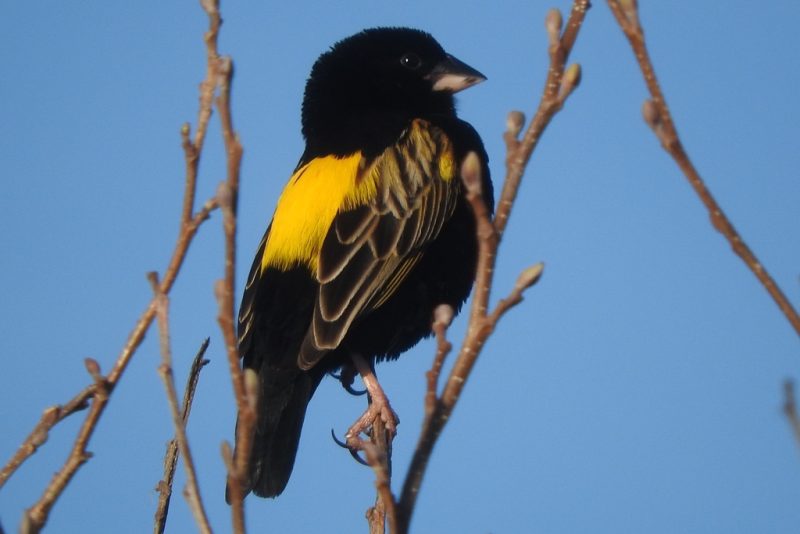
The Yellow Bishop is a small, striking bird most notable during the breeding season when males display a glossy black body with vivid yellow patches on the shoulders, rump, and parts of the wings. Outside of the breeding season, both sexes appear more subdued, with brown and streaked plumage that helps them blend into grassland habitats.
Native to sub-Saharan Africa, this species inhabits grasslands, wetlands, and agricultural fields. It is commonly found in countries such as South Africa, Kenya, and Uganda. The Yellow Bishop tends to favor areas with tall grasses or reeds, which offer excellent cover and nesting materials.
Their diet consists mostly of seeds and small insects. During the breeding season, males become territorial and perform fluttering display flights to attract mates. The nest is a well-concealed, domed structure made of grass and placed close to the ground, often hidden among dense vegetation.
Golden-bellied Starfrontlet (Coeligena bonapartei)
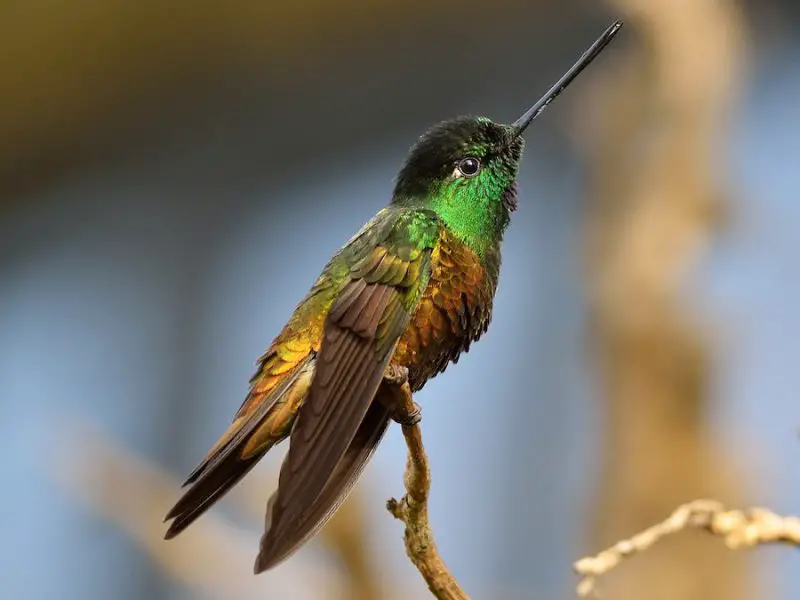
The Golden-bellied Starfrontlet is a dazzling hummingbird species characterized by its iridescent golden-yellow underparts, contrasted with dark metallic green or purplish wings and upperparts. The bird also has a slightly curved bill adapted for feeding on nectar.
This species is native to the montane cloud forests of Colombia and western Venezuela, typically found at elevations between 1,800 and 3,600 meters. It inhabits humid forest edges, shrublands, and areas near flowering plants, often perching quietly before darting to feed.
Golden-bellied Starfrontlets feed primarily on nectar from a wide variety of flowers but also consume small insects and spiders for protein. They are solitary and highly territorial, especially around feeding sites. Males are known for their rapid aerial chases to defend nectar-rich flowers from other hummingbirds.
Masked Yellowthroat (Geothlypis aequinoctialis)
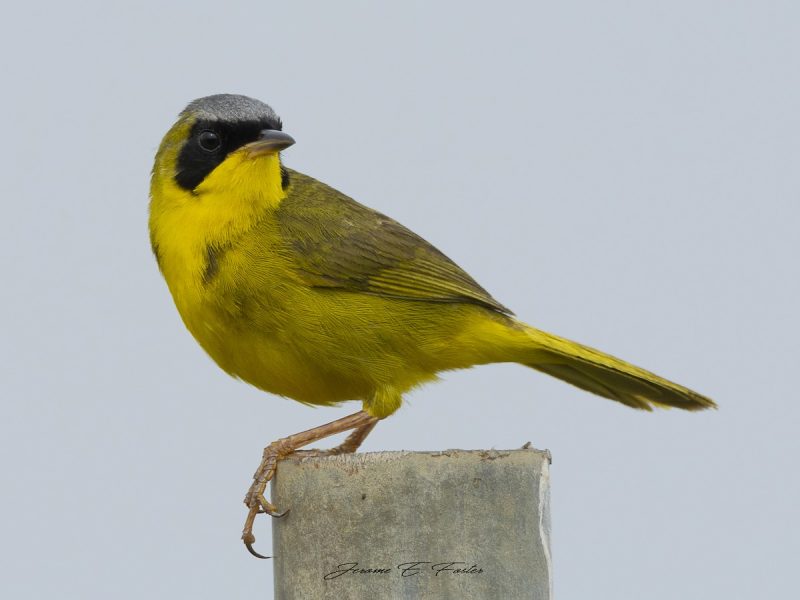
The Masked Yellowthroat is a small, warbler-like bird with a bright yellow body and a distinctive black facial mask in males. Females are duller and lack the bold facial markings. Both sexes have olive-greenish upperparts and relatively plain, dark wings.
It is widely distributed throughout much of South America, from Panama and Colombia down to Argentina. Masked Yellowthroats prefer marshes, grassy wetlands, forest edges, and overgrown fields where they can forage among low vegetation.
These birds primarily eat insects and other small invertebrates, which they glean from foliage or catch by hopping through dense undergrowth. They are secretive and often remain hidden, though their sharp, chattering calls can help locate them. Breeding pairs build cup-shaped nests low in the vegetation.
Orange-crowned Oriole (Icterus auricapillus)
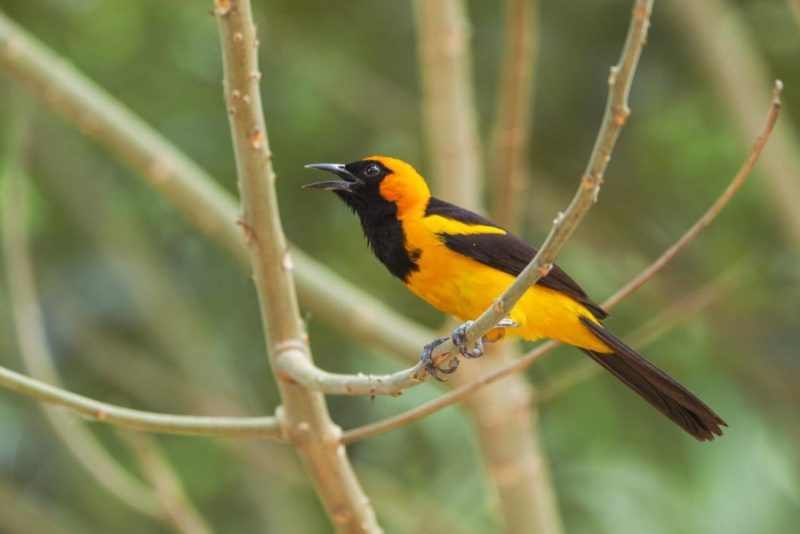
The Orange-crowned Oriole is a colorful bird with a vibrant orange-yellow body, contrasting black wings, and a dark crown atop its head. The name refers to the rich, almost orange hue that covers most of its body, especially noticeable in adult males.
This oriole species is found in the humid lowland forests of northern South America, with its range concentrated in Colombia and Venezuela. It prefers forest edges, secondary growth, and woodland clearings where fruit-bearing trees are abundant.
Its diet includes fruits, nectar, and insects, much like other orioles. The Orange-crowned Oriole is known for its fluty, melodic song, which is often heard from high in the canopy. Nests are typically suspended from the tips of tree branches, woven tightly from plant fibers and other natural materials.
Yellow-backed Oriole (Icterus chrysater)

The Yellow-backed Oriole stands out with its brilliant yellow back and underparts, sharply offset by a black head, throat, and wings. This striking color contrast gives the bird a bold appearance, especially when it is perched in open branches or flying between trees.
It inhabits a wide swath of Central America and northern South America, with populations in countries such as Honduras, Nicaragua, Costa Rica, Colombia, and Venezuela. Yellow-backed Orioles prefer tropical lowland forests, plantations, and wooded savannas, often remaining in the middle to upper canopy.
Feeding primarily on fruits, nectar, and insects, this species plays a vital role in pollination and seed dispersal. They are also vocal birds, producing a series of rich whistles and chattering notes. Their nests are deep, hanging baskets suspended from the tips of tree limbs, often well hidden among leaves.
Golden-breasted Starling (Lamprotornis regius)
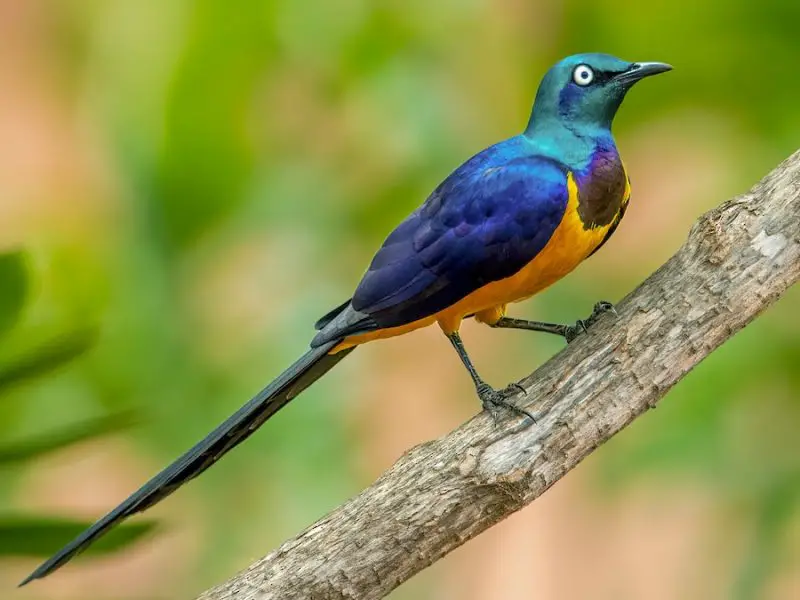
The Golden-breasted Starling is a dazzling bird with metallic, iridescent plumage. Its breast glows a vivid golden-yellow, while the wings, back, and tail shimmer in shades of green, blue, and purple. This species is also known for its long, elegant tail and glossy appearance, making it one of Africa’s most visually striking birds.
Native to East Africa, it inhabits dry savannas, open woodlands, and thornscrub areas, especially in countries like Somalia, Kenya, and Ethiopia. Golden-breasted Starlings often forage in small flocks and are known for their social nature, frequently engaging in cooperative breeding.
Their diet includes insects, fruits, and berries. They are skilled foragers, often hopping on the ground or probing tree bark. These birds are also vocal, producing a variety of whistles and clicks. Nests are typically built in tree cavities and are lined with grasses and feathers.
Yellow-tufted Honeyeater (Lichenostomus melanops)
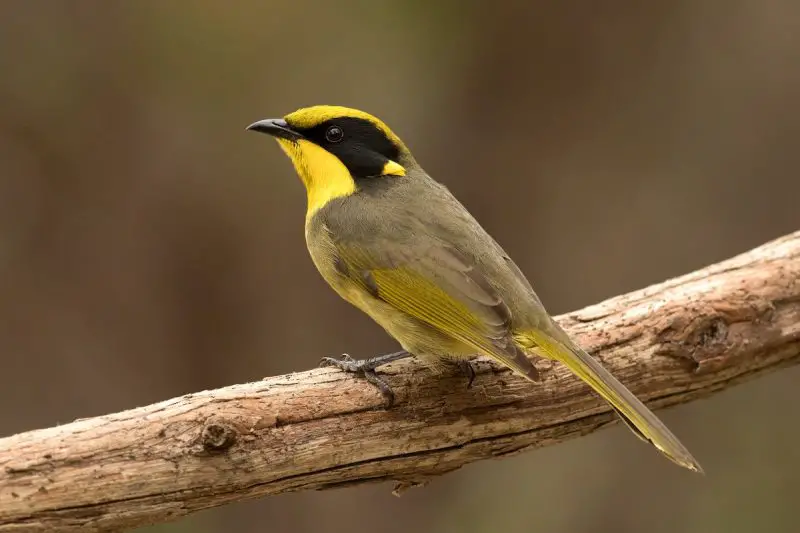
The Yellow-tufted Honeyeater is a distinctive Australian bird with a bright yellow body and prominent black markings on its face and wings. Its name comes from the small yellow tufts behind its eyes, which are especially noticeable in adult birds.
This honeyeater is found in southeastern Australia, inhabiting dry sclerophyll forests, woodlands, and shrublands. It prefers areas with dense undergrowth and abundant flowering trees, especially eucalypts, which provide a steady source of nectar.
As a member of the honeyeater family, its diet includes nectar, fruits, and insects. Yellow-tufted Honeyeaters are energetic and noisy, often forming social groups and engaging in loud chattering. They are also known to be territorial during the breeding season, which occurs mainly in spring and summer.
Yellow-crowned Bishop (Euplectes afer)
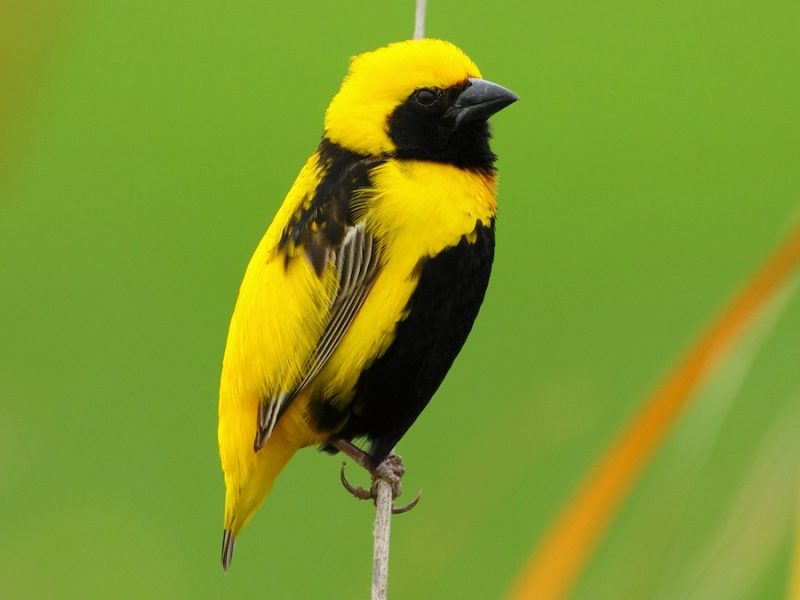
The Yellow-crowned Bishop is a small, vibrant bird most remarkable during the breeding season when males don a brilliant yellow plumage with bold black wings, face, and underparts. Outside of the breeding season, they resemble females, with streaked brown and yellowish coloring.
Native to sub-Saharan Africa, this species thrives in wetlands, tall grasses, and agricultural fields. It is commonly seen near marshes and along riverbanks, often gathering in large flocks during the non-breeding season.
These birds feed primarily on grass seeds and small insects. Breeding males display dramatically by puffing up their bright feathers and performing fluttering flights over their territories. They build oval-shaped nests hidden within dense vegetation, usually suspended from tall grass stems or reeds.
Streak-backed Oriole (Icterus pustulatus)
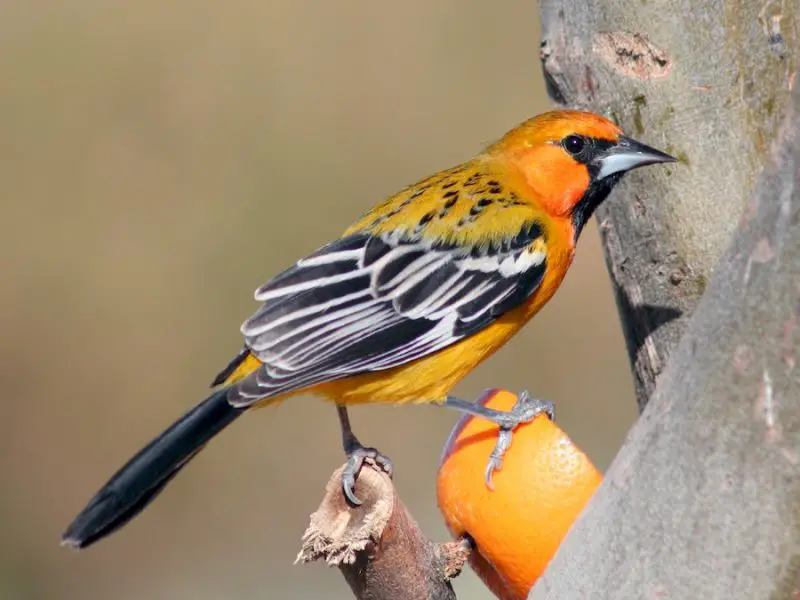
The Streak-backed Oriole is a boldly colored bird with a bright yellow-orange body, black-streaked back, and black wings accented with white bars. It has a strong, slightly curved bill and dark eyes, adding to its sharp appearance.
This species is native to western Mexico and parts of Central America, including Honduras and Nicaragua. It favors tropical and subtropical dry forests, forest edges, and scrubby areas, often found near open woodlands or plantations.
Its diet consists of insects, fruit, and nectar. Streak-backed Orioles are known for their flutelike calls and songs, which they use to defend territories and attract mates. They construct hanging, pouch-like nests high in trees, usually well-concealed among dense foliage.
Black-vented Oriole (Icterus wagleri)
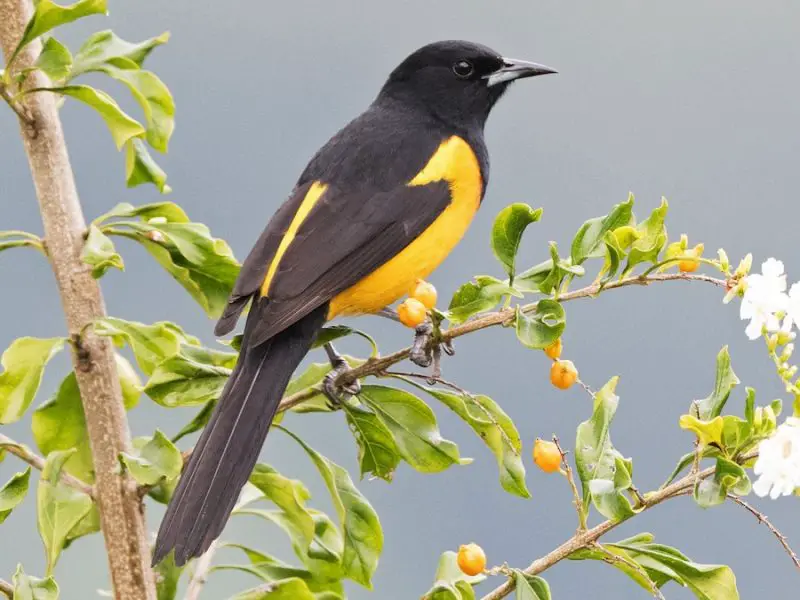
The Black-vented Oriole is a striking bird with bright yellow underparts and contrasting black head, wings, and upper back. As its name suggests, the area around the vent is also black. This combination gives it a sharp, bold appearance.
This species is found in the mountainous regions of Mexico and Central America, inhabiting pine-oak forests, cloud forests, and forest edges at mid to high elevations. It prefers areas with dense vegetation and is often seen foraging among tree canopies.
Its diet includes insects, fruits, and nectar. Black-vented Orioles are generally solitary or seen in pairs and are less social than some other orioles. They are known for their melodious whistles and often build deep, woven nests suspended from high branches.
Yellow-shouldered Blackbird (Agelaius xanthomus)
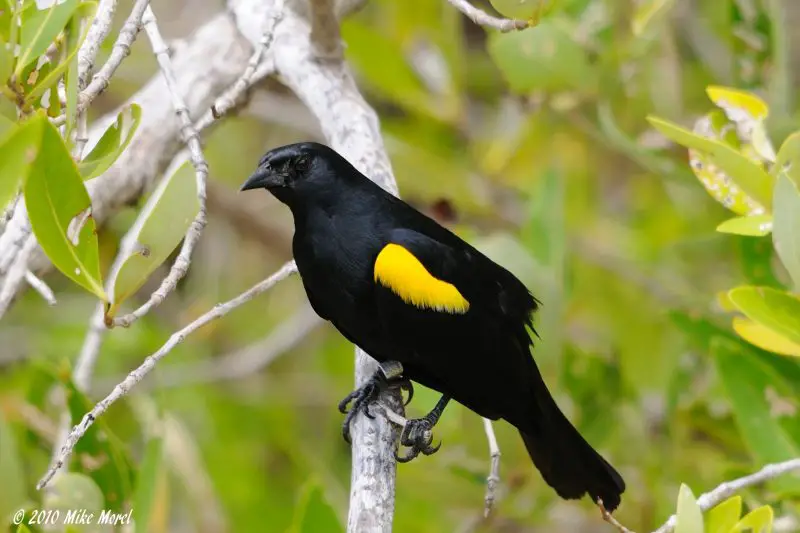
The Yellow-shouldered Blackbird is an entirely black bird with a striking splash of yellow on its shoulders, which is especially prominent when the wings are spread. It has a sharp, pointed bill and a sleek body, resembling other members of the blackbird family but distinguished by its shoulder coloration.
This species is endemic to Puerto Rico, meaning it is found nowhere else in the world. It inhabits coastal mangroves, brushy areas, and occasionally inland forests, particularly near water sources. It relies heavily on undisturbed habitats for successful nesting and survival.
The Yellow-shouldered Blackbird primarily feeds on insects, fruits, and seeds. It nests in small colonies, building cup-shaped nests in mangroves or shrubs. The species is classified as endangered due to habitat loss and predation by introduced species, prompting conservation efforts to protect its remaining populations.
Black-and-yellow Tanager (Chrysothlypis chrysomelas)
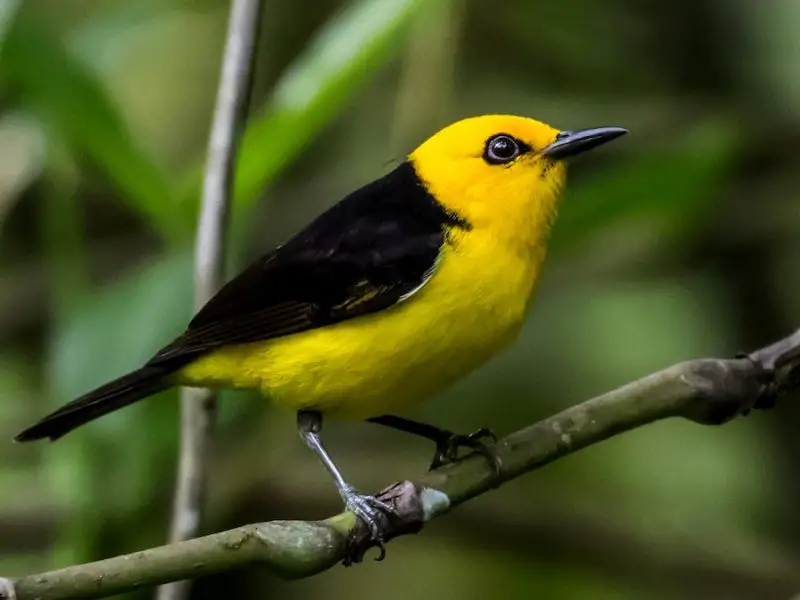
The Black-and-yellow Tanager is a visually striking bird with a bright yellow body contrasted by a black head and wings. It is small and compact with a relatively short tail, making it easy to identify among other tanager species.
This bird is native to humid forests of Central America, particularly in Costa Rica and Panama. It prefers the canopy and edges of lowland and foothill forests, where it is often seen flitting about in mixed-species foraging flocks.
It feeds primarily on small insects and fruits, often plucking them from foliage or branches. The Black-and-yellow Tanager is known for its quick, agile movements and soft, high-pitched calls. Though sometimes difficult to spot in dense foliage, its bright coloration gives it away when it emerges into light.
Yellow-winged Cacique (Cassiculus melanicterus)
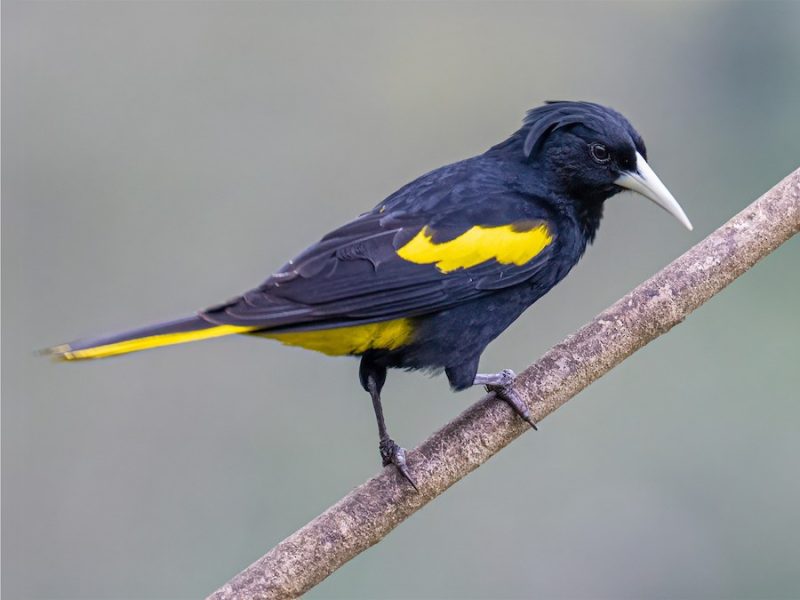
The Yellow-winged Cacique is a large, sleek bird that is predominantly black with bright yellow patches on its wings and rump. These vivid yellow markings are most visible during flight, offering a dramatic contrast to its otherwise dark appearance.
This species is found along the Pacific coast of Mexico, from Sonora to Oaxaca. It inhabits tropical and subtropical dry forests, mangroves, and semi-open woodlands, often near water or forest clearings.
Its diet consists of insects, fruit, and nectar, and it is known for its loud, varied vocalizations. Yellow-winged Caciques are social birds, often forming loose colonies during the breeding season. They build long, hanging nests woven from grasses and fibers, suspended from the ends of branches high in trees.
Yellow-throated Bush Tanager (Chlorospingus flavigularis)
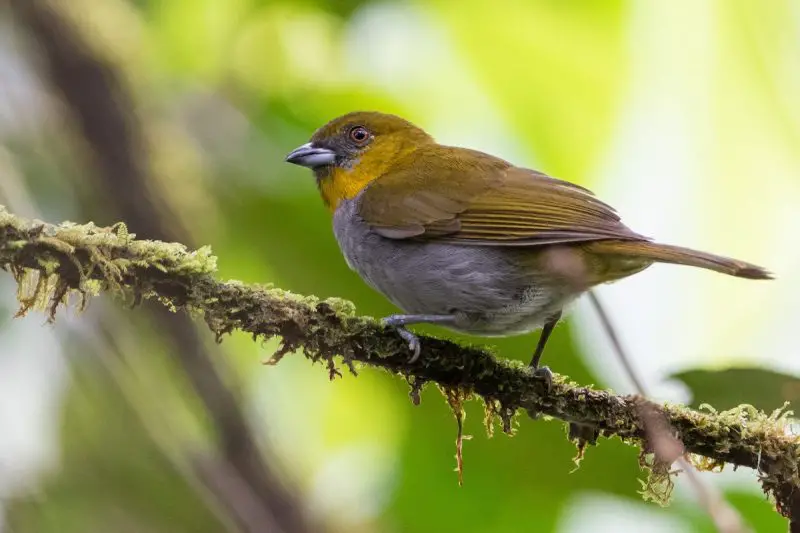
The Yellow-throated Bush Tanager is a small songbird with an olive body, yellow underparts, and a distinctive yellow throat. Its wings and back are darker, often with dusky or blackish tones, and it has a short, stout bill well-suited for its omnivorous diet.
This bird is found in the highland forests of Central America and the Andes, thriving in cloud forests, humid montane woodlands, and dense understory vegetation. It prefers elevations between 1,000 and 3,000 meters, often in areas rich in epiphytes and moss.
It feeds on insects, berries, and seeds, usually foraging in pairs or small groups. Yellow-throated Bush Tanagers are known for their soft, whistled calls and frequent participation in mixed-species flocks. They build cup-shaped nests hidden in shrubs or among hanging vines, often close to the forest floor.
Yellow-hooded Blackbird (Chrysomus icterocephalus)
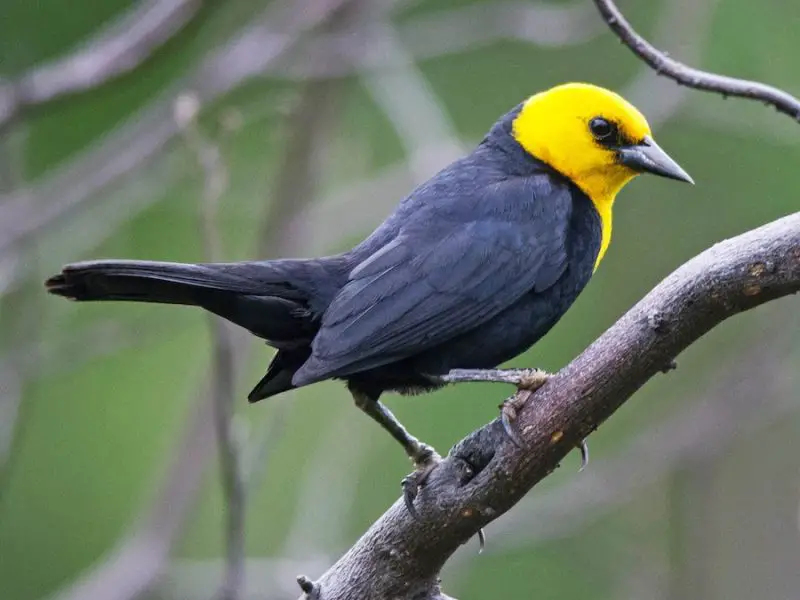
The Yellow-hooded Blackbird is a visually striking species with a bright yellow head, chest, and belly, contrasted by black wings, back, and tail. Males are especially vibrant, while females are more subdued in coloration with brownish tones.
This bird inhabits the wetlands and marshy grasslands of northern South America, including countries like Venezuela, Colombia, and parts of the Amazon Basin. It prefers open areas with reeds, tall grasses, or floating vegetation.
Its diet is primarily composed of seeds, insects, and small aquatic invertebrates. Yellow-hooded Blackbirds are gregarious, often forming flocks and nesting in colonies. Males perform dramatic display flights and sing buzzing songs to attract females. Their nests are woven among reeds or grasses, usually near the water’s edge.

